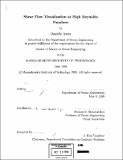Shear flow visualization at high Reynolds Numbers
Author(s)
Ames, Danielle, 1974-
DownloadFull printable version (41.47Mb)
Advisor
Michael S. Triantafyllou.
Terms of use
Metadata
Show full item recordAbstract
The mechanisms responsible for various disturbances in the wakes of ships have been investigated for some time. Efforts to define and characterize the contributing factors and resulting turbulent wake manifestations conclude that ship length, speed and geometry play integral and interdependent roles. Previous experimentation in the Ocean Engineering Towing Tank at MIT on small scale model ships supplied data for Reynold's Numbers up to ~ 0(106). The work included in this thesis represents a continuation of those efforts up to Re O(107) using a model DDG51 (5514) Destroyer. Through endeavors to identify wake phenomena and closely examine possible sources, previously unvisualized charicteristics were revealed and the calibration, comparison and validation of numerical simulations were made possible. Experimental efforts were concentrated on the study of flow in the wake and near the bow of the model DDG-51 Destroyer (5514). Qualitative and quantitative flow visualization methods were adapted, designed and implemented including ship-fixed and tank fixed streak videography and Digital Particle Image Velocimetry (DPIV). In addition, the experimental apparatus was modified for similar flow visualization near live fish, and a description of this endeavor and its progress are included.
Description
Thesis (S.M.)--Massachusetts Institute of Technology, Dept. of Ocean Engineering, 1998. Includes bibliographical references (leaves 92-94).
Date issued
1998Department
Massachusetts Institute of Technology. Department of Ocean EngineeringPublisher
Massachusetts Institute of Technology
Keywords
Ocean Engineering